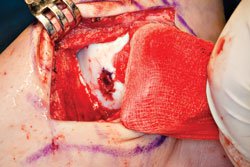Long-term study shows marked functional improvement with ACI in the talus
Autologous chondrocyte implantation of the talus yielded significant functional improvement up to 10 years in patients who had failed previous surgery, according to a recently presented study.
“This is a worthwhile endeavor, despite the technical difficulty of the procedure,” lead author Steve K. Kwak, MD, an orthopedic surgeon at North Jersey Orthopaedic Specialists in Teaneck, N.J., said.
“These young patients have really terrible lesions in their talus and previous surgery has failed,” Kwak told Orthopedics Today. Autologous chondrocyte implantation (ACI) “is another way of transferring what we know about the knee down into the ankle and seeing if these patients could get better with some new cartilage.”
|
Image: Kwak SK |
Failed previous surgery
Kwak and his colleagues studied 29 patients who underwent ACI for osteochondral lesions. Preoperatively, 23 patients had medial lesions and six had lateral lesions. Patients had an average lesion size of 198 mm2 and had failed previous surgery.
Cartilage samples were cultured and multiplied in the lab for 4 to 5 weeks, Kwak said. The cultured chondrocytes were then returned and injected into the defected cartilage of the ankle at a minimum of 6 weeks after harvest.
Patient outcomes were evaluated by simplified symptomatology, Tegner activity score, Finsen score and the American Orthopaedic Foot and Ankle Society (AOFAS) hindfoot score. Patients had a mean follow-up of 70 months.
‘Surprising’ results
“It was a little bit surprising how well these results lasted,” Kwak said. “There are worries that ACI results will deteriorate over time, but study patients remained pain-free and remained functionally well.”
Preoperatively, 26 patients rated their ankles as poor and three patients rated their ankles as fair. At last follow-up, nine patients classified their ankles as excellent, 14 as good, five as fair and one as poor. Furthermore, Tegner, Finsen and AOFAS scores all showed significant improvement.
“Most patients claimed their ankle to be nearly normal,” said Kwak, who presented results at the 2011 Annual Meeting of the American Academy of Orthopaedic Surgeons. “This is very encouraging considering that previous surgery did not improve their situation.”
Twenty-five patients had a second-look arthroscopy at the time of hardware removal, which occurred more than 1 year after ACI. Kwak said that the examination showed nearly normal restored cartilage. One patient exhibited significant fraying of the cartilage and some mild arthritic changes.
Based on the results, Kwak expects the functional improvement to continue out to at least 20 years. – by Bob Kronemyer
Reference:
- Kwak SK, Ferkel RD, Kern BS. Autologous chondrocyte implantation of the ankle: 2 to 10 year follow-up. Paper #94. Presented at the 2011 Annual Meeting of the American Academy of Orthopaedic Surgeons. Feb. 15-19. San Diego.
- Steve K. Kwak, MD, can be reached at North Jersey Orthopaedic Specialists, 730 Palisade Ave., Teaneck, NJ 07666; 201-353-9000; email: stevekwakmd@gmail.com.
- Disclosure: Kwak has no relevant financial disclosures.
The authors present promising 2- to 10-year results of the use of autologous chondrocyte implantation (ACI) for talar lesions. It is particularly encouraging that these results occurred in patients that failed prior surgery and had significant preoperative symptoms. The availability of second-look arthroscopy in a large percentage of the patients also provides qualitative support to further bolster the findings of improved functional outcomes.
This study supports ACI as a promising option in patients that have failed prior attempts at surgical management of a talar lesion. Future controlled trials would be helpful in clarifying the role ACI in comparison to other common salvage options including osteoarticular transplantation.
— Nelson F. SooHoo, MD
Orthopedics
Today Editorial Board member
Associate Professor, University of
California Los Angeles School of Medicine,
Los Angeles, CA
Disclosure:He has no relevant financial disclosures.


